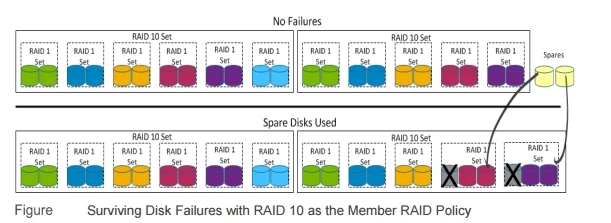Question 6 of 56
A customer has a single-member group with a RAID policy of RAID 6 in the default storage pool. A second member with a RAID policy of RAID 10 is added.
What are two valid ways to add the second member? (Choose two.)
What are two valid ways to add the second member? (Choose two.)
Correct Answer: A, D
Setting the member RAID policy -
When a new group is created, or a new member is added to an existing group, the RAID policy must be selected before the space on the member is available
Incorrect: Answers -
B, C: The default pool has a RAID 6 policy.
Note:
RAID 10 Striping on top of multiple RAID 1 (mirrored) sets, with one or two spare disks (depending on the total number of disks in the array).
The figure below represents a RAID 10 configuration protected by RAID and two spare disks.

References: Dell PS Series Storage: Choosing a Member RAID Policy, page 27 http://en.community.dell.com/dell-groups/dtcmedia/m/mediagallery/19861480/download AD
When a new group is created, or a new member is added to an existing group, the RAID policy must be selected before the space on the member is available
Incorrect: Answers -
B, C: The default pool has a RAID 6 policy.
Note:
RAID 10 Striping on top of multiple RAID 1 (mirrored) sets, with one or two spare disks (depending on the total number of disks in the array).
The figure below represents a RAID 10 configuration protected by RAID and two spare disks.

References: Dell PS Series Storage: Choosing a Member RAID Policy, page 27 http://en.community.dell.com/dell-groups/dtcmedia/m/mediagallery/19861480/download AD
Question 7 of 56
Which three settings are unique when creating a thin volume? (Choose three.)
Correct Answer: C, D, F
Question 8 of 56
An administrator needs to change the RAID type from RAID 10 to either RAID 50 or RAID 6.
What must the administrator select before Modify RAID Configuration within the Activities pane?
What must the administrator select before Modify RAID Configuration within the Activities pane?
Correct Answer: B
Question 9 of 56
According to Dell recommendations, when should a firmware update be performed on a PS Series group?
Correct Answer: B
Question 10 of 56
A VMware administrator requests the creation of a 100 GB volume to use as a datastore on an ESX environment. The SAN administrator completes the request.
For a few days, the VMware administrator is able to access and use the datastore. The VMware administrator then reports that the VM located on the datastore is greyed out and labelled as inaccessible.
What are three possible reasons for this problem? (Choose three.)
For a few days, the VMware administrator is able to access and use the datastore. The VMware administrator then reports that the VM located on the datastore is greyed out and labelled as inaccessible.
What are three possible reasons for this problem? (Choose three.)
Correct Answer: B, C, E